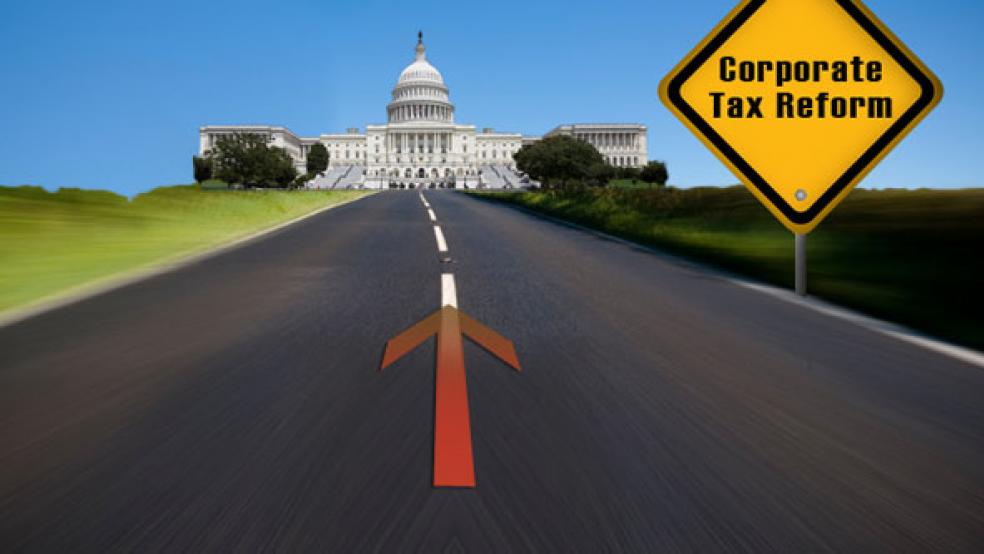In the run-up to the “fiscal cliff” deadline of December 31, the debate over how best to restore some balance to the nation’s books revolved around personal income tax rates, and in particular, whether or not to tax the wealthiest Americans at a higher rate. This time around, with “sequestration,” or $85.3 billion of mandatory spending cuts, scheduled to kick in at the beginning of March, the focus has shifted to the defense budget. It won’t be long, though, before we’re delving into corporate tax rates as President Obama presses Congress to scare up more revenue from various sources.

On paper, U.S. tax rates for corporations look draconian: The highest marginal tax rate of the major nations surveyed by the Organization for Economic Co-operation and Development, with a federal statutory rate of 35 percent, or 39 percent including a weighted average of state taxes. The key word there is “statutory.” A more significant word might be “effective”; and that’s important because in fiscal year 2011, the OECD notes that the effective tax rate for U.S. corporations was among the lowest for its member nations.
Just as individuals can deduct items like mortgage interest payments against their own tax liability, so companies have a host of deductions available to them. And even though U.S. companies (like individuals) are taxed on their income worldwide, those deductions and loopholes lower the effective U.S. corporate tax rate to a mere 12.1 percent, far below the OECD average effective rate of 16 percent, below Canada at 14.5 percent and well below Australia, whose CEOs may really have something to grumble about, given that their actual tax burden is a whopping 30.5 percent.
The end result is that the federal government generates far less in corporate tax revenue from domestic companies than its counterparts worldwide. In fact, the strategy research team at Goldman Sachs calculates that only about 10 percent of companies in the S&P 500 have paid the statutory tax rate over the last decade, with the median effective tax rates for the 500 companies now at 30 percent.
While the statutory rate has stayed steady for the last 25 years, that effective tax rate has fallen. And oddly, some of the companies that you’d think of as receiving special breaks actually pay some of the highest effective tax rates: Among S&P 500 groups, the energy sector pays the highest effective tax rates, Goldman Sachs calculates.
That offers the government, at least, a win-win solution. Congress could easily respond to the popular clamor to lower the actual tax rate on corporations while still boosting its corporate tax income by ensuring that more businesses are paying a higher effective rate. (That won’t satisfy some think tank pundits, who, using a different methodology, arrive at different conclusions than the OECD and suggest that our effective tax rate is still higher than the OECD average.)
What does that mean for investors? Well, the Goldman Sachs strategy team argues that while effective tax rates vary widely across sectors, for every percentage point the effective tax rate climbs, the return on equity within the S&P 500 would drop 0.22 percentage points and earnings per share for the index would fall by $1.50 a share.
Goldman’s strategists have come up with a way to protect you from such a scenario by identifying companies that are most sensitive to a change in the tax laws. One group pays low effective tax rates that might go up depending on how Congress rewrites the laws. The other list comprises ten companies paying the highest effective tax rate.
The companies with high rates had roughly similar forecasts for sales and profit growth as the average S&P 500 company, Goldman pointed out, but also carried a higher valuation. Moreover, this group outperformed the S&P 500 during 2012 by 1.5 percentage points, as investors recognized the vulnerability associated with companies that pay a low effective corporate tax rate.
The stocks Goldman feels most at risk (the low tax group) include cruise line company Carnival, which has paid an average effective tax rate of 2 percent in the last decade, health-care standout Agilent, with an average effective tax rate of 18 percent in the same time period, Western Digital (7 percent), Ingersoll Rand (16 percent), brewing giant Molson Coors (17 percent), General Electric (16 percent) and a group of insurers led by XL Group (11 percent). The groups that stand out as having particularly low tax rates are the health care industry (which includes biotech companies) and information technology.
On the other side of the coin, companies already paying heavy effective tax rates – and likely to suffer less or perhaps outperform on a relative basis – are scattered among a variety of sectors, even including heath care and technology. Potential “winners” in this basket include Goodyear Tire and Rubber, which has paid a whopping 55 percent effective tax rate over the last decade; Marathon Oil (47 percent) and a cluster of other integrated energy companies; futures exchange company CME Group (41 percent), Whole Foods Market (40 percent), The Washington Post (39 percent), CVS Caremark (39 percent) and Charles Schwab (38 percent).
When the revenue-raising and cost-cutting discussions in Washington turn to corporate taxes, as they likely will sooner or later, these lists offer a good starting point for anyone trying to figure out which businesses have a big bull’s eye painted on their back – and which face less risk from the potential reforms.






